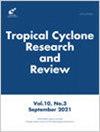Sub-seasonal variability of tropical cyclone landfall characteristics on the west coast of the Bay of Bengal during October–December: The role of La Niña and El Niño
IF 4.1
4区 地球科学
Q3 METEOROLOGY & ATMOSPHERIC SCIENCES
引用次数: 0
Abstract
Tropical cyclones (TCs) create more disasters when they make landfall. Climatologically, the west coast of the Bay of Bengal (BoB), one of the most densely populated geographical regions over the globe, is more vulnerable to TC landfall during the primary TC season (October–December), with around 72% of TCs originating in the BoB making landfall on the west coast of BoB (WCBoB). However, the evidence for reliable interannual modulation of sub-seasonal variability on landfalling TCs during the primary TC season in the BoB has been explored less. Here, we used the 35 years (1988–2022) of best TC track data from the BoB to investigate this aspect. Those TCs that made landfall on the WCBoB indicate a significant meridional shift between the first and second half of the primary TC season in the La Niña regime, with 93% (83%) of TC formed in the first (second) half of the season making landfall in the north WCBoB (south WCBoB). Our study reveals that the meridional shift in genesis location and difference in steering flow between the first and second halves of the season is principally responsible for the sub-seasonal variability of landfall location in the La Niña regime, in which former characteristics seem to be determined by southward propagation of Genesis Potential Index (GPI). GPI magnitude is lower in the El Niño regime than in the La Niña regime during the primary TC season, resulting in lower TC activity without sub-seasonal variability in the landfall characteristics in the BoB.
10 - 12月孟加拉湾西海岸热带气旋登陆特征的分季节变化:La Niña和El Niño的作用
热带气旋(TCs)登陆后会造成更多灾难。气候学上,孟加拉湾西海岸(BoB)是全球人口最密集的地理区域之一,在初级热带气旋季(10 - 12月)更容易受到热带气旋登陆的影响,约72%源自孟加拉湾的热带气旋在孟加拉湾西海岸登陆(WCBoB)。然而,在北半球主要的温带季节,对温带登陆的次季节变率的可靠年际调节证据的探索较少。在这里,我们使用了来自BoB的35年(1988-2022)最佳TC轨迹数据来研究这方面的问题。登陆WCBoB的TC表明La Niña政权的初级TC季前(后)半季之间有明显的经向转移,其中93%(83%)的TC形成于前(后)半季,登陆WCBoB北部(WCBoB南部)。研究结果表明,La Niña地区登陆位置的亚季节变异主要是由成因位势指数(GPI)向南传播决定的,成因位势的经向移动和季节前、后半段转向流的差异造成的。在初始TC季,El Niño模式的GPI值低于La Niña模式,导致赤道东段的TC活动较低,而登陆特征没有次季节变化。
本文章由计算机程序翻译,如有差异,请以英文原文为准。
求助全文
约1分钟内获得全文
求助全文
来源期刊

Tropical Cyclone Research and Review
METEOROLOGY & ATMOSPHERIC SCIENCES-
CiteScore
4.60
自引率
3.40%
发文量
184
审稿时长
30 weeks
期刊介绍:
Tropical Cyclone Research and Review is an international journal focusing on tropical cyclone monitoring, forecasting, and research as well as associated hydrological effects and disaster risk reduction. This journal is edited and published by the ESCAP/WMO Typhoon Committee (TC) and the Shanghai Typhoon Institute of the China Meteorology Administration (STI/CMA). Contributions from all tropical cyclone basins are welcome.
Scope of the journal includes:
• Reviews of tropical cyclones exhibiting unusual characteristics or behavior or resulting in disastrous impacts on Typhoon Committee Members and other regional WMO bodies
• Advances in applied and basic tropical cyclone research or technology to improve tropical cyclone forecasts and warnings
• Basic theoretical studies of tropical cyclones
• Event reports, compelling images, and topic review reports of tropical cyclones
• Impacts, risk assessments, and risk management techniques related to tropical cyclones
 求助内容:
求助内容: 应助结果提醒方式:
应助结果提醒方式:


